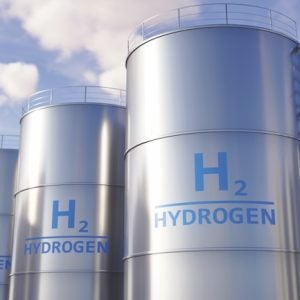
For the projected significant increase in nuclear power utilisation over the next few decades to be achieved will require developing and deploying advanced technologies such as small modular and advanced reactors for new facilities. However, it will also depend on maximising the performance and lifespan of the existing global nuclear fleet. To meet that goal will mean addressing and overcoming challenges faced by existing nuclear power plants.
The Kozloduy NPP is the sole operating nuclear power plant in Bulgaria and is also the largest in the region. Situated some 180 kilometres north of the capital construction of the first reactor at the site began in 1970 but Units 1 to 4 had all been shut down by 2007 as part of Bulgaria’s ascension to the European Union. Units 5 and 6, which are still operating, are Soviet-built VVER-1000 V-320 pressurised water reactors that were commissioned in 1987 and 1991, respectively. They generate about one-third of Bulgaria’s electricity supply. Since commissioning of the units a number of different modernisation and upgrading programmes have been implemented including for the instrumentation and control systems. For example, in 2020 Kozloduy NPP signed a contract for the migration of Unit 5 and 6 computer information and control system to the latest generation Ovation platform, as well as partial modernisation of the Full Scope Simulator for the reactor units. The contract came as part of a programme of works that will extend the life of the units by 30 years and will see the plant operate for at least 60 years. Unit 5 is now due to operate until at least 2047 and unit 6 to 2051.

A critical part of the plant life extension programme is the timely modernisation of information and control systems which ensures compliance with stringent international nuclear standards and enables the power units to operate safely and efficiently.
In March 2023 a consortium of companies led by RPC Radiy was awarded a contract for the modernisation of the Reactor Control and Protection System. Following a programme of works undertaken by RPC Radiy and Radics LLC, the subsequent successful launch of Power Unit 6 at Kozloduy NPP took place in 2024. Radiy is an engineering company working in the design, manufacturing and installation of Field Programmable Gate Array (FPGA)-based digital instrumentation and control systems for nuclear power plants and research reactors. Radics also delivers instrumentation and control systems to improve plant safety and reduce maintenance cost. Radiy/Radics LLC designed, manufactured, delivered, and commissioned the Reactor Trip System and Reactor Power Discharge and Limitation Equipment. These systems were designed and developed based on the advanced digital RadICS Platform, in which the components adhere to the latest IEC standards for safety critical services in the highest classified nuclear systems. The RadICS Platform includes a Logic Module, basic input/output modules, and specialty modules all housed in a seismically qualified chassis. Certified as SIL 3 capable in a single channel by exida in 2014 and approved by the US Nuclear Regulatory Commission in 2019, the RadICS Platform has proven reliability in safety-related applications.

This latest project followed on from an earlier initiative from Radics to replace outdated equipment at Kozloduy dating back to 2007. The earlier project saw the installation of a new Engineered Safety Features Actuation System (ESFAS) units at Units 5 and 6. This upgrade improved plant operations, enhanced safety, reduced operating costs, and mitigated risks of technological obsolescence. Designed with advanced FPGA technology, the ESFAS systems installed in 2008 have operated flawlessly for over 15 years, underscoring the benefits of plant modernisation.

More advanced modernisation
The newly installed RadICS-based equipment replaced older Russian-made systems and deliver substantial improvements, significantly enhancing operational safety and reliability. Value-added benefits include:
Reliability enhancements:
- Simplified system design: A reduction in total system modules and cables thanks to FPGA technology and optical communication channels.
- Increased cybersecurity: Redesigned digital networks enhance cyber resilience, ensuring no interference with Class 2(A) equipment.
- Advanced self-diagnostics: Covers over 95% of potential faults, ensuring rapid troubleshooting and fault indication.
- Improved data archiving: Duplicated servers archive process and diagnostic information with a resolution of
5 milliseconds, enabling detailed emergency analysis.
Operational enhancements:
- Improved control algorithms: Enhanced algorithms for power regulation provide more accurate adaptation to reactor kinetics equations.
- Accurate power calculations: Refined calculations of plant thermal power and operational limits during various equipment shutdowns.
- Optimised repair procedures: Refuelling machines and polar cranes now adapt to seismic sensor data for improved repair processes.
- False protection reduction: The principle of ‘2oo3’ – two out of three majority voting are required for the system to operate – data processing at all levels, including output generators, minimises any false protection activations.
- Fault propagation prevention: Extensive use of galvanic signal separation improves safety during transmission, processing, and output command generation.
Personnel and maintenance benefits:
- Hot-swap functionality: Allows replacement of system modules without de-energizing.
- Error prevention in module installation: A mechanical coding system prevents incorrect module placement.
- Enhanced protection settings: Special engineering stations with secure communication channels facilitate prompt adjustments.
- Streamlined diagnostics: Advanced diagnostic systems display module statuses and pinpoint failed
components. - Algorithm verification automation: An automated system reduces verification time and documentation requirements.
- Process simulation and monitoring: Operational displays provide real-time plant parameters, including built-in simulation capabilities for power regulation and limitation.
As part of the modernisation project, Radiy and Radics teams delivered extensive training to Kozloduy NPP personnel. The programme, developed to meet the customer’s requirements, was approved by Kozloduy NPP specialists and included an online theoretical course which was broadcast from Radiy’s I&C Training Center along with hands-on troubleshooting exercises. Presentations and video materials introducing conceptual aspects of the new generation Reactor Control and Protection System, as well as instructions on its operation and maintenance, were also provided to participants ahead of the training. This programme equipped Kozloduy engineers with the skills and knowledge needed to operate, maintain, and troubleshoot the upgraded systems effectively.
Supporting Europe’s energy future
Energy safety and security are critical for Bulgaria and the broader European Union where over 100 power reactors are producing more than 22% of all the EU electricity. As energy demand grows, nuclear power will remain a significant source of electricity for the next 20 years. Indeed, studies on the future of nuclear power convincingly demonstrate the belief that this technology will continue to develop, as it remains a critical option to meet future energy demands and reduce carbon dioxide emissions alongside other atmospheric pollutants.
Timely modernisation of information and control systems ensures compliance with stringent international nuclear standards, enabling power units to operate safely and efficiently. The RadICS Platform flexibility across reactor types offers a viable solution for extending the lifecycle of European NPPs while maintaining safety and meeting regulatory demands.
The successful collaboration between international vendors and utilities strengthens European’s energy stability and reinforces nuclear power’s vital role in addressing future energy needs. By embracing advanced nuclear technologies, like the RadICS Platform, Europe can improve energy security, strengthen its energy independence, and secure a stable, carbon-free electricity supply for the future.






